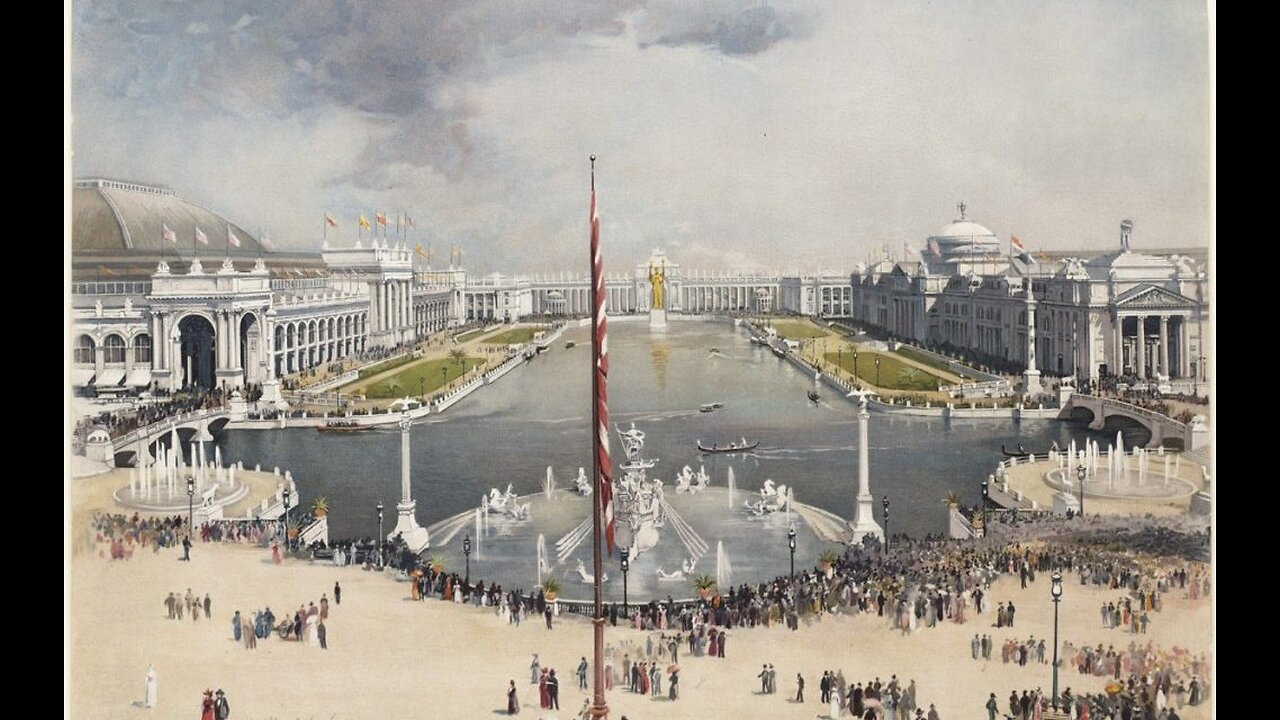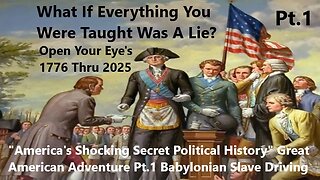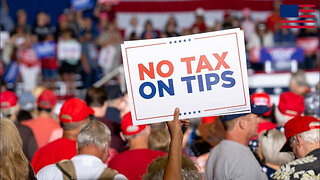Premium Only Content

Chicago Old Museum Tell About 1,000 Year Old World History Of 1893 World's Fair !
So From 1,000s Year Old Map from Great Lake Area A City is Named > Tartaria > Shikaakwa > Checagou > Chicago > So Maybe the History we've been told is a lie! Were some ancient buildings built by a different race and their true history was covered up? Did ancient peoples have advanced forms of technology that have now been forgotten? Was the massive kingdom of Tartaria visible on ancient maps much more advanced than we realize? This sub is an open forum for collaborative discussion of all topics "Tartaria" related, including Mud Flood, Tesla, Antiqui-Tech, Free Energy, Conspiracies, Hidden History, etc.
As the largest user of electricity in the 19th century, the 1893 World’s Columbian Exposition was nicknamed “The White City.” and is a old Tartaria City from 1492 ? Old Chicago looks More like Gotham or Roman City. I think that it was one worldwide civilization, It was all based on unity, oneness, peace, love, and harmony, which we don’t see in today’s society.” There’s an arch-traditionalism present in the theory, too. The pre-modern buildings that we venerate are sometimes said to be more than 1,000 years old. “The same people that built the Capitol City All Over The World. Narrated by Gene Wilder, this film explores the world of 1893 through a cinematic visit to Chicago's Columbian Exposition. Many of the world's greatest achievements in art, architecture, science, technology and culture are unveiled there. The 1893 World's Fair was an engineering marvel. How did 10,000 unskilled workers build 200 marvelously incredible buildings? Not just that, but they built them in 2 years. They are said to be built temporary.
World’s Columbian Exposition, fair held in 1893 in Chicago, Illinois, to celebrate the 400th anniversary of Christopher Columbus’s voyage to America.
Three women were famously attributed to the moniker Little Egypt, who first gained notoriety at the 1893 Chicago’s World Fair. A belly dancer named Farida Mazar Spyropoulos, nicknamed Little Egypt backstage due to her large size, was said to have stolen the show out of all of the dancing girls. She famously danced to the song “The Streets of Cairo.” Another Little Egypt Fatima Djemille danced for Thomas Edison’s “Coochie Coochie Dance” film in 1896, while Mark Twain reportedly had a near fatal heart attack in 1898 after watching Spyropoulos gyrate and shimmy.
In the United States there had been a spirited competition for this exposition among the country’s leading cities. Chicago was chosen in part because it was a railroad centre and in part because it offered a guarantee of $10 million.
Continuing the precedent set at the Philadelphia Centennial Exposition (1876) of creating a vast gardened layout containing numerous separate buildings rather than a single great hall, the World’s Columbian Exposition was planned to spread over 686 acres (278 hectares) along the city’s south lakefront area; part of this location is now Jackson Park in Chicago. The chief planner was the Chicago architect Daniel H. Burnham; Charles B. Atwood was designer in chief; and Frederick Law Olmsted was entrusted with landscaping. The fair’s new buildings had impressive Classical facades with a uniform cornice height of 60 feet (18.25 metres). The plaster palace fronts bore little functional relationship to exhibition halls inside; but the grandeur of the “White City,” electrically lighted at night, temporarily led to a resurgent interest in Classical architecture.
Behind the calm pillared facades and Classical porticoes of the great “White City” the visitor found unexpected excitement and novelty. The Ferris wheel (invented by G.W.G. Ferris, a Pittsburgh engineer) and a dazzling new wonder—electricity—were presented for the first time in America. Electricity had been introduced and exploited at the Paris Exposition of 1889, but in 1893 it was still unfamiliar to most Americans. The exposition was opened by a dramatic act when U.S. Pres. Grover Cleveland pushed a button on a ceremonial platform in front of the Administration Building and set the great Allis engine in motion, turning on the electric power for the exposition. The engine, the dynamo, and the alternating-current generator displayed for the first time by George Westinghouse later became the basic tools of the electric power industry.
The Columbian Exposition’s gross outlays amounted to $28,340,700, of which $18,678,000 was spent on grounds and buildings. There were some 21.5 million paid admissions to the exposition, and actual total attendance (including free admissions) was more than 25.8 million. However, because some visitors were counted twice, the total figure is sometimes reported as having been between 27 and 28 million. The cash balance remaining at closing was $446,832, making it the first American international exposition to close with a profit. The Palace of Fine Arts, a 600,000-square-foot building, was rebuilt in permanent limestone in 1928–32 to house the public exhibitions of the Museum of Science and Industry.
The glittering dreamland, built in Chicago’s Jackson Park along the shores of Lake Michigan, was considered the greatest World’s Fair of all time. It provided a once-in-a-lifetime experience that drew over 25 million visitors. Guidebooks recommended spending two weeks there.
People would travel to the exposition at all costs. Advised author Hamlin Garland: “Sell the cook stove if necessary, but come to the Fair.”
Those of us who were not around in 1893 can get a taste of the lakefront spectacle in the galleries of Opening the Vaults: Wonders of the 1893 World’s Fair, an exhibition running through Sept. 7 at Chicago’s Field Museum. The objects on display, all part of the museum’s collection, have rarely—if ever—been seen by the public since the fair’s six-month run ended 121 years ago.
Enlarged archival photos, including some projected on screens and with sound effects, also bring the event to life. Prominent on the White City’s skyline was the first Ferris wheel. The 2,160-passenger, 250-foot-high ride stood 100 feet taller than today’s wheel at Navy Pier.
Marking the city’s recovery from the Great Fire of 1871 and offering visitors a snapshot of Western civilization during a time of social turmoil and technological advances, the fair celebrated the 400th anniversary of Christopher Columbus coming to America. Nearly 200 buildings displayed 65,000 artifacts.
The fair actually led to the founding of the Field Museum, one of Chicago’s great treasure houses. Fair artifacts were the basis of the museum’s original collection, and the men who had been involved in organizing the exposition were the first board members and curators of what was then the Field Columbian Museum, which opened June 2, 1894 at the fair’s Palace of Fine Arts (the only fair building still standing and now the Museum of Science and Industry). The Field Museum has been at its current Lake Shore Drive location since 1921.
Enter the first exhibit gallery and you’re greeted with ragtime piano music, which was introduced to the public at the fair. African-American musicians would play ragtime outside the fairgrounds. While blacks were not prevented from visiting the fair, they were excluded from its planning and development and only hired for menial jobs and as entertainers. On display is a program from the Aug. 25 “Colored American Day,” the fair’s only gesture of inclusivity. Equal rights activist Frederick Douglass was the keynote speaker. The room’s other assorted artifacts under glass include a fossil dragonfly and canteen fashioned from a rare double coconut, plus coins and a souvenir handkerchief commemorating the fair.
With a growing interest in natural history in the late 19th century, taxidermied animals caught the public’s imagination and were popular with fairgoers. Mounted species from around the world, like the mountain lion and passenger pigeon in the current exhibit, were showcased at the fair by Ward’s Natural Science Establishment. After the fair, the Field Museum purchased Ward’s entire collection and ever since has been noted for its animal dioramas. Opening the Vaults also shows some of Ward’s meteorites, minerals and gems that drew fairgoers to the Mines and Mining Building.
Economic botany was more important than environmentalism at the time, so many fair exhibits showcased products made from oils, woods, grains and fibers. See oils in their original containers, including a bottle of orange resin (chicle), an ingredient in Wrigley’s Juicy Fruit Gum, one of many products unveiled at the fair. Other new foods included Shredded Wheat and Cracker Jack. A shawl made from tree bark and a skirt of coconut fiber and pine needles also illustrate how natural materials were used for practical purposes.
The World’s Fair approached anthropology from a 19th century perspective, depicting non-Western cultures as exotic and less advanced. In reconstructed “native” villages, Americans for the first time rubbed elbows with people from Africa, the South Pacific and other faraway places as they performed tasks and put on shows. American Indians also were represented. Cultural artifacts on display range from Crow Nation horse parade regalia to Peruvian mummies (with an adjacent computer station that lets you “see” inside the wrappings). Also view a Zulu shield, Javanese theatrical masks and weapons from New Caledonia. A pushbutton display presents an actual recording of music from the 1,000-seat theater of the midway’s Java Village, and a touch screen lets you play an Indonesian gamelan, an ensemble of wind, string and percussion instruments.
America hosted the World's Fair of 1893 as a celebration of Columbus' voyage to the continent four hundred (and one) years earlier. Chicago beat out New York, St. Louis and Washington, D.C. for the privilege of hosting the fair. Like the 1876 Centennial Exposition before it, the Fair provided a showcase for American power — and a reflection of the nation's prevailing values.
The board supervising the fair invited Frederick Law Olmsted, America's premier landscape architect, to develop a site and plan for the fair. With his partner Harry Codman, Olmsted chose Jackson Park on Lake Michigan. Rather than design a landscape, Olmsted and Codman conceived of a spectacular seascape. Along with the lake itself, a series of artificial pools and canals would contrast with islands and raised terraces for the buildings. An arrangement of buildings around a terrace had been used at the last World's Fair, in Paris of 1889 -- but the Chicago site was four times larger.
Daniel Hudson Burnham, of the Chicago architectural partnership Burnham and Root, the chief of construction for the fair, enthusiastically adopted this proposal. Burnham then suggested that the greatest American architects of the time contribute designs for the buildings. The contributors included Richard Morris Hunt (who built the façade of the Metropolitan Museum in New York), Charles McKim (New York Public Library), Robert Peabody, George B. Post (New York Times building), Henry Van Brunt, Louis Sullivan, and William LeBaron Jenney (Home Insurance Building of Chicago, among the first with a steel skeleton). The sculptor Augustus Saint-Gaudens, as artistic director, oversaw the decorative program of the fair, which included works by Daniel Chester French, who later created the statue of Lincoln for that president's memorial, and the Impressionist painter Mary Cassatt.
When the architects met in Chicago in 1891 to share their designs with one another, Olmsted noted, "the general comradeship and fervor of the artists was delightful to witness & more delightful to fall into." Together, they collaborated on a magnificent vision -- and enjoyed their own audacity in dreaming it up. Saint-Gaudens compared the group to the Italian Renaissance geniuses who built Florence. "Look here, old fellow," he said to Burnham, "do you realize that this is the greatest meeting of artists since the fifteenth century!"
The Neo-Classical buildings of Hunt, McKim and the other eastern architects stood around a basin in the Court of Honor; Sullivan's multicolored Transportation Building was off to one side. A mile-long commercial strip, the Midway Plaisance, provided entertainments nearby.
The Court of Honor's buildings served as exhibition halls, housing the newest inventions and appliances for the home and farm, many of them powered by electricity. Visitors gawked at electric incubators for chicken eggs, electric chairs for executions, an electric sidewalk, an early fax machine that sent pictures over telegraph lines, electric irons, sewing machines and laundry machines, and Thomas Edison's Kinetoscope, the first moving pictures. For many of the fairgoers, Edison's fourteen-year-old invention, the electric lightbulb, was a novelty they had never seen before. That the Court was lit at night was itself astonishing. The exhibits helped to demystify the many mysterious new inventions of the age.
The seascape conception worked beautifully. Newly designed electric boats, quieter and smaller than steam-powered boats, carried fair-goers around the site. There were also Venetian gondolas, a Norwegian Viking ship, a Japanese dragon boat and replicas of the Niña, the Pinta and the Santa Maria. The World's Fair Steamship Company ran ferries from midtown to the fair with live music on board and the best view of Chicago available for 15 cents.
"The influence of the Exposition on architecture will be to inspire a reversion toward the pure ideal of the ancient," Burnham wrote. Although individual architects like Olmsted and Sullivan were unhappy with the idea of privileging of classical European design over homegrown American styles, Burnham succeeded. The World's Columbian Exposition established a Neo-Classical revival in Chicago and across America.
Although the Court of Honor influenced American architecture for decades to come, most visitors to the fair were more impressed with the Midway.
Performances of classical music and other uplifting entertainments were scheduled for the buildings of the Court of Honor of the World's Columbian Exposition, Neo-Classical buildings arranged around a basin and connected by footbridges over canals and lagoons. The Court of Honor was having trouble competing with the Midway, however, and the concerts were poorly attended. Theodore Thomas, the fair's musical director, resigned halfway through the exposition, recommending that for "the remainder of the Fair music shall not figure as an art at all but be treated merely on the basis of an amusement."
Taking his suggestion to heart, and trying to lure fairgoers from the Midway, the Court of Honor started featuring John Philip Sousa marches. Moreover, the Court was host to donkey races, boat and swim races in the lagoon, international tug-of-war contests, tightrope-walking, and parachute drops. Clearly, the spirit of the Midway had overtaken the "White City" of the Court of Honor.
The Midway's most outstanding feature from afar was George Washington Gale Ferris's gigantic wheel ride -- the first Ferris wheel ever built. This was a direct response to Gustave Eiffel's tower for the Paris fair of 1889. The attraction featured 140-foot-high towers and a 250-foot-diameter wheel whose apex brought riders to a point higher than the crown of the Statue of Liberty. For fifty cents each, 1.4 million riders went for two revolutions. A New York entrepreneur ordered a half-sized wheel for his park in Coney Island, telling a reporter, "We Americans want either to be thrilled or amused, and are ready to pay well for either sensation."
The Midway performers included the escape artist Harry Housini, ragtime pianist Scott Joplin, and Buffalo Bill Cody and his Wild West Show. There were also beauty contests, dwarf elephants, a two-headed pig, boxing matches and Hindu jugglers.
For the first time, hungry Americans were offered hamburger sandwiches and fizzy, carbonated soft drinks. They could even get a new-fangled postcard to send to their friends.
There were talks by the local reformer Jane Addams, by suffragettes Susan B. Anthony and Elizabeth Cady Stanton, by the famed lawyer Clarence Darrow, future president Woodrow Wilson, and by the socialist Samuel Gompers. Historian Frederick Jackson Turner gave his seminal paper on the closing of the American frontier at the Fair, and Oliver Wendell Holmes spoke on literature.
International exhibits included German and Irish villages, mosques, a Cairo street, an Indian reservation, half-naked Dahomeyan villagers and Algerian belly dancers. But there was no acknowledgement of the more than eight million African Americans.
Civil rights leader Frederick Douglass complained that the only examples of African culture on display were the villagers from Dahomey. He organized a Colored People's Day at the fair and was jeered at and ridiculed — until he spoke. The Exposition was, among other purposes, the largest reconciliatory event since the Civil War, held while lynching was on the rise in the South. Douglass said: "We Negroes love our country. We fought for it. We ask only that we be treated as well as those who fought against it."
Similarly, the Native American exhibits, organized by the curator of Peabody Museum of Harvard University, were criticized by one of the staff members because they were "used to work up sentiment against the Indian by showing that he is either savage or can be educated only by Government agencies.... Every means was used to keep the self-civilized Indians out of the Fair." The staff member, Emma Sickles, was fired.
The World's Columbian Exposition was wildly popular. In the six months that it operated, 27 million people visited the fair. That number is astounding today, but even more so when one considers that the population of the United States was only 63 million in 1890, or that there was an economic depression at the time and families mortgaged farms and houses, or borrowed on their life insurance, to visit. This was Chicago's — and America's — showcase, a chance to set a standard and an agenda for the century that was to come.
How did 10,000 unskilled workers build 200 marvelously incredible buildings? Not just that, but they built them in 2 years. They are said to be built temporary, but this book shows that they were in fact built with material such as Iron, Steel, Glass and Wood. Is there more to the story that we aren't being told? In any case, it was a marvelous feat of architecture and planning.
The name "Chicago" is derived from a French rendering of the Native American word shikaakwa, known to botanists as Allium tricoccum, from the Miami-Illinois language. The first known reference to the site of the current city of Chicago as "Checagou" was by Robert de LaSalle around 1679 in a memoir.
I made it back to my adopted hometown Chicago, but no blatant Indian-ness imagery was to be seen in the areas in which I spent time—the downtown area, Hyde Park, and northern suburbs. However, the word “Chicago” comes from the Miami-Illinois word “Shikwaakwa,” which means “striped skunk” or “smelly onion.”
-
 50:46
50:46
What If Everything You Were Taught Was A Lie?
19 days agoAmerica's True Shocking Secret Political History Great American Pt.1 Babylonian Slave Driving
2.79K10 -
 2:59:34
2:59:34
Barry Cunningham
5 hours agoWATCH LIVE: DOGE SUBCOMMITTEE HEARING!
36.2K19 -
 1:29:32
1:29:32
Simply Bitcoin
4 hours ago $2.93 earnedNEW REPORT PROVES This Bitcoin Bull Run is DIFFERENT!! | EP 1191
41.4K -
 1:23:50
1:23:50
Russell Brand
5 hours agoAI Visions, War Deals, and the Next Big Lockdown? – SF544
116K16 -
 1:18:31
1:18:31
vivafrei
6 hours agoCanadian Liberal Leadership Race TO THE BOTTOM! Florida Prosecutor Claims SELF DEFENSE? & MORE!
55.4K32 -
 3:08:48
3:08:48
Right Side Broadcasting Network
7 hours agoLIVE REPLAY: President Trump Participates in First Cabinet Meeting - 2/26/25
118K28 -
 1:57:29
1:57:29
The Charlie Kirk Show
3 hours agoJudges vs. The People + Is DOGE Enough? + Fort Knox | Rep. Roy, Glenn, Plume, Posobiec | 2.26.2025
90.5K14 -
 2:39:35
2:39:35
The White House
5 hours agoPresident Trump Hosts First Cabinet Meeting, Feb. 26, 2025”
74.4K45 -
 58:16
58:16
The Dan Bongino Show
6 hours agoShake-Up In The White House Press Room (Ep. 2431) - 02/26/2025
920K1.17K -
 1:00:00
1:00:00
The Rubin Report
5 hours agoDem Looks Visibly Angry as Stephen A. Smith Points Out Failures to His Face
84.2K57